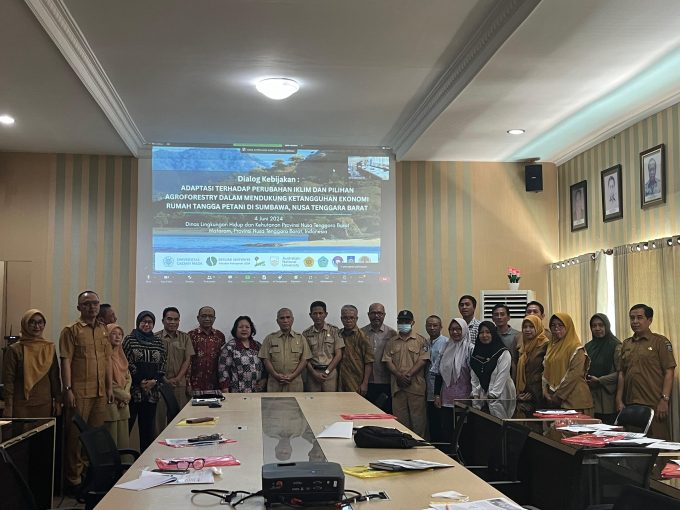
The KONEKSI research team successfully executed the second provincial-level research results dissemination and policy dialogue. This activity was carried out on 4 June 2024, hybridly, at the Environment and Forestry Serviceof West Nusa Tenggara (Dinas Lingkungan Hidup dan Kehutanan Provinsi Nusa Tenggara Barat) and through the zoom meeting platform. The title of this second dissemination of research results and policy dialogue was ‘Adaptation to Climate Change and Agroforestry Options in Support of Economic Resilience of Farmer Households in Sumbawa, West Nusa Tenggara’.
The event was opened by Dr. Ir. H. Iswandi, M.Si as the Head of the Regional Development Planning Agency of West Nusa Tenggara Province. His presentation on Low Carbon and Climate Resilient Development Policy in the Perspective of Sustainable Land Management highlighted that NTB as a food barn cannot lift the welfare of the community, hence transformation is needed to utilize its potential, including maritime. He also said that the main priorities of the Regional Long-Term Development Plan (Rencana Pengelolaan Jangka Panjang Daerah / RPJPD) 2025-2045 are productivity, people, planet, power, and prosperity. It can be seen that the priority is to increase productivity and human resource development.
Furthermore, Julmansyah, S.Hut., M.A.P as the Head of the Environment and Forestry Service of West Nusa Tenggara Province delivered a presentation on the Smart Agroforestry System Development Policy in supporting the achievement of Forest and Other Land Use (FOLU) Net Sink 2030. In his presentation, he said that greenhouse gas emissions in NTB come from deforestation and degradation, especially on the border of Dompu and Bima. In line with this deforestation and degradation, maize production in Sumbawa has increased. He also highlighted the importance of socializing agroforestry as the people of Sumbawa are still unfamiliar with this system.
Prof. Dr. Ir. Budiadi, S.Hut., M.Agr.Sc. IPU. from Gadjah Mada University, as a specialist in agroforestry and ecosystem, explained the outline of the KONEKSI project and the achievements of activities in the three locations namely Maluku, NTB, and NTT. The dissemination of research results and policy dialogue at the provincial level is one of the research components after the scoping study, survey, and Focus Group Discussion and training. Important keywords in his presentation were agroforestry, climate change, gender-sensitive, and policy.
A presentation on the activities and achievements of the survey, FGDs, and training entitled Important Lessons from the Site Level in the Implementation of Sustainable Agroforestry Systems as well as the Project Team Activity Report were presented by Prof. Ir. Muktasam, M. Agr.Sc., Ph.D. from Mataram University. Some of the crops proposed to be developed in Batu Dulang are candlenuts, coffee, durian, and whole wood. While in Pelat are durian, corn, and fruits. In Batu Ladung, agroforestry can be practiced based on fruits, while in Pelat it can be based on food crops with the main types being corn, rice, and beans. The role of women is quite dominant in domestic activities, while men are involved in agricultural and social activities.
The presentation on the Initiation of Result Based Payment (RBP) in West Nusa Tenggara Province was delivered by Dr Andi Chairil Ichsan, S.Hut., M.Si., C.EIA from Mataram University. Based on the Forest Reference Emission Level (FREL) document, NTB was given a mandate of 2.6 million for emission allocation which already contained several activities in the REDD+ architecture. A total of 770,000 Ha area is the location of the operational plan for emission reduction.
An introduction to Climate Smart Agroforestry (CSAF) as a gender-sensitive climate adaptation and mitigation strategy was delivered by CIFOR senior researcher Ani Adiwinata, PhD. Climate Smart Agroforestry (CSAF) complements Climate Smart Agriculture (CSA) – integrating all components of agroforestry and orientated towards climate mitigation and adaptation. Commodity selection is based on community preferences, with consideration of CSAF development and principles.
The activity continued with a discussion of three main topics: agroforestry, climate adaptation and mitigation, and policy. This discussion session resulted in several points. On the topic of CSAF, CSAF is possible to be applied in the context of NTB, in addition to the climate context, CSAF can also be applied to meet the needs of wood, food, and others. In addition, CSAF has the potential to be applied given the condition that maize expansion is declining. CSAF is possible to be included in the Concept Note Result Based Payment of NTB Province. It can also contribute to the implementation of Integrated Area Development (IAD) and Social Forestry. There are already various schemes, such as Social Forestry (SF) and Climate Change Program (Proklim), that have implemented agroforestry that could potentially transition to CSAF. Batu Dulang and Pelat can be developed as pilots in the implementation of CASF.
Climate change adaptation and mitigation discussion points include CASF Adaptation Challenges: 1) water infrastructure (ponds and piping), 2) community capacity, 3) funding support, 4) technology and information. Proposals: 1) Water infrastructure development, 2) strengthen community empowerment, 3) microfinance-cooperatives, 4) strengthening technology and information to be more responsive. CASF Mitigation challenges: 1) Provision of seeds/seedlings and 2) quality of seeds/seedlings. Proposal: 1) Water infrastructure development, 2) more intensive community facilitation, 3) microfinance-cooperatives, 4) strengthening technology and information to be more responsive. CASF Mitigation challenges: 1) Provision of seeds/seedlings and 2) quality of seeds/seedlings. Proposals: 1) Communities or SF groups can apply to BPDAS, 2) seed/seedling certification. Results of discussion on policies include: There are a series of policies that can support CSAF implementation: Integrated Area Development, Social Forestry, One Resort One Demplot, village fund. CSAF implementation needs to be supported by a master plan that also includes risk analysis. If CSAF will be included as one of the activities in the RBP Concept Note, then indicators are needed to assess more fairly in distributing funds. If CSAF is included in the concept note, then indicators are needed to assess the distribution of the activity.
